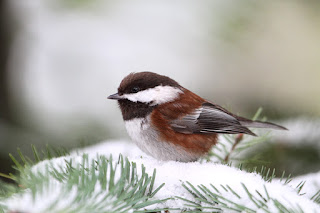How do birds, especially the tiny hummingbirds, survive the cold weather?
For all birds, survival means finding enough food to make it through the day. Birds live one day at a time and don't really stock up on energy. They start searching for food with the sunrise, and stop when the sun sets again. This doesn't leave them much leeway if the weather takes a turn, or their natural food sources are scarce.
During snowfall, some bird species become more reliant on the supplementary food sources in backyard feeders. With snow hiding seeds and berries, and the cold chasing insects away from the surface, it can be difficult for birds to find enough food to make it through the day. This is the time when backyard feeders, including suet feeders, can get very busy. We saw this in December when the snow hit.
The importance of food is obvious, but water is also critical during winter since most of it ends up frozen. Providing a dish of water for the birds is useful and can help attract different birds that may not eat at your feeders. Make sure if you're putting out water you use a shallow dish (2" at the deepest) and keep it from freezing. Changing the water if it starts to frost over or adding a bird bath heater are some options to keep the water flowing.
As the sun sets, it's time for the birds to settle in and roost for the night. Many species have gathered into flocks for the winter, and these flocks will find a spot together to roost. Roosting spots can be a tree or shrub, an empty nest box, or a tree cavity. These roosting spots help shelter the birds from the weather. Roosting in a flock can also help the birds conserve a bit of energy through the night.
The Anna's hummingbird lives on Vancouver Island year round and does not migrate over winter. This is not, as some believe, due to the presence of hummingbird feeders but simply because the Anna's are a non-migratory species to begin with. Having a hummingbird feeder up during winter can help provide these little birds with the energy they need to find food. Hummingbird sugar-water gives them the energy to keep going but it doesn't provide them with any nutrition. The Anna's look for small insects and tree sap as a source of nutrients. During winter, there have even been a few reports of hummingbirds following Red-breasted Sapsuckers to feed at the sap wells that the sapsuckers make in trees.
Hummingbirds can find it difficult to keep warm at night due to their lack of down feathers. In order to conserve enough energy to survive until morning, hummingbirds enter a hypothermic state known as torpor. This torpor state allows hummingbirds to slow their metabolic rate and lower their body temperature. While in torpor, the hummingbird's heart rate drops from approximately 1200 beats a minute down to 50. Without this torpor state, the hummingbird's metabolism is so fast they could starve overnight.
Have you ever spotted a hummingbird hanging upside down from your bird feeders? They are in the torpor state! To avoid falling off their chosen perch, hummingbirds 'lock' their feet into position.
If you do find a hummingbird in a suspected torpor state, the best thing to do is leave them alone and make sure that (if you have a hummingbird feeder) your nectar is out and unfrozen. It's very difficult to determine if the hummingbird is in a torpor, as they will be completely unresponsive until they've woken.
Good birding!




No comments:
Post a Comment